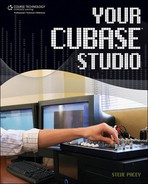Getting Rid of Unwanted Reflections
Because the sound of a room is always changing, it’s important that you remain aware of your surroundings when you are recording. In a lot of Cubase home studios, this can be a difficult task because you’re in the room where the recording is taking place. When I’m in this situation, I sometimes need to close my eyes and try to concentrate only on what I’m hearing in the headphones because that is what is being recorded.
Unwanted reflections can come from a lot of different sources. For instance, if a singer is using a music stand, he or she may be creating an unwanted metallic tone in the recording, or a guitar amp pointed toward a wall may be creating a “small room” sound. These are just two scenarios of an endless number of possibilities. As I go over recording techniques for guitars, vocals, and bands, I will also explain how you can get the best recording possible to avoid unwanted reflections.
You should have some key tools by your side to deal with these unwanted reflections when they pop up in the studio. As I mentioned before, carpet is great for manipulating reflections. Some studios that want a very dead room choose to carpet not only their floors, but also the walls and sometimes even the ceiling. This is a bit extreme; such measures are usually not desirable because they can suck the good sound from a recording along with the bad. But if you have extra rugs or carpet you can access as you need them (in moderation), you may be able to save a recording.
Blankets, towels, pillows, drapes, and curtains are also very handy to have. Like carpet, each of these items is very porous, sound-absorbing material. If you had to, you could even use your dirty gym socks to help kill some unwanted reflections. For instance, throwing a towel over a music stand will kill that metallic reflection, and hanging a drape on a wall may take away that small room reflection from a guitar amp. Pillows are great for kick drums, and blankets are great for pianos. Just don’t put your dirty gym sock on the singer’s microphone! Read the section “Studio Feng Shui and an Efficient Workspace” later in this chapter.
Most studios go the extra mile and use things that you can’t find just lying around your home. For instance, instead of using a bedroom blanket as a piano baffle, you’d probably find a studio using a packing blanket (see Figure 3.3).
Figure 3.3. Studio packing blankets for troubleshooting acoustic problems.

In a studio, these packing blankets are useful for more than just moving furniture. Draping packing blankets over some chairs or tacking them to a wall can dramatically improve the way a room sounds.
Studio baffles are also a necessity, especially when recording multiple instruments at once. A well-constructed studio baffle not only can eliminate unwanted reflections, but can also provide some necessary isolation between instruments and amplifiers.
Acoustic foam is polyurethane foam that has been shaped to absorb sound. Because foam is usually thicker than carpet, it can be very good at capturing high-frequency reflections that are out of control. Two popular manufacturers of this foam are Sonex and Auralex. Even though these manufacturers strive for perfection in acoustical foam, you can also find similar, less expensive foam sold for packing/shipping or bed rolls. Egg cartons yield a similar result, but although they reflect sound in a less threatening way, they don’t absorb sound nearly as well as polyurethane foam. Unless you’re trying for a sound from 1956, I recommend sticking to the polyurethane foam (see Figure 3.4).
Figure 3.4. Auralex acoustic studio foam, great for high-frequency reflections.

Acoustic foam can be great for solving reflective corners in a room, a common problem. The foam scatters the sound and absorbs some itself. Some people think that covering a room in carpet or acoustic foam will eliminate any sound passing in or out of the studio. This is not at all true. Carpet and foam tend to control high-frequency reflections, which are very directional, as opposed to low-frequency sound, which is not so directional and much harder to control.
